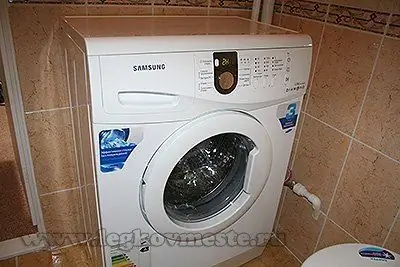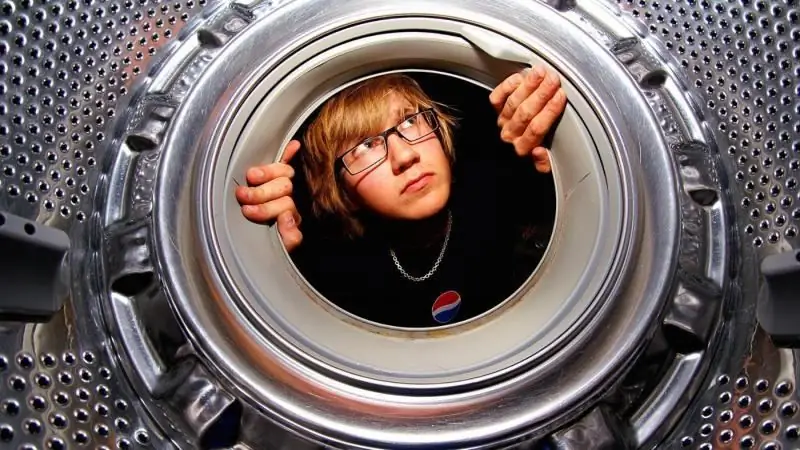
Table of contents:
- Author Bailey Albertson [email protected].
- Public 2023-12-17 12:53.
- Last modified 2025-06-01 07:32.
Anti-scale citric acid in the washing machine: how to clean

Limescale builds up in the washing machine, even from clean tap water. At high temperatures, insoluble particles of washing powder settle on the heating element, increasing the lime layer on the heating element. Everyone knows that the scale must be removed. Did you know that ordinary citric acid can help with this?
The action of citric acid
Hard water is one of the main causes of plaque formation, which can ruin the washing machine. To avoid this, you can call the wizard from the service center, but his work will cost a lot. And there is not always a need for outside help. Surely your case is not running, and you can easily cope with the problem with citric acid, spending a minimum of money. This method is also much cheaper than using special washing powders recommended by the machine manufacturers.

Citric acid will help you get rid of scale as well as special products
Citric acid belongs to the class of carboxylic acids that react actively with metals and salts in water. When exposed to high temperatures, these salts precipitate, forming a layer of scale on the heating element. Initially, this leads to an increase in energy consumption (scale poorly conducts heat and transfers it to water), and then - to burnout of the heating element. The citric acid dissolves the salts and the plaque disappears.
Washing machine cleaning process
The method is very simple, and to implement it you only need:
- several bags of citric acid;
- sponge or cloth.
- First of all, see if there are any small items left under the rubber parts of the washing machine. Do not put laundry in the drum, as cleaning will take place in idle mode. Acid can not only help you by dissolving limescale, but also ruin the fabric.
- Pour citric acid into the powder compartment or directly into the drum. The amount depends on the volume of the machine. For example, if the machine holds 4 kg of laundry, you will need about 60 grams, if 5 kg or more - from 100 to 120 grams.
- Set the wash cycle with rinse and spin. For example, it could be a 60 degree cotton wash. This method is suitable if the plaque layer is thin, and for prevention. If you suspect that there is a lot of limescale, select the longest setting at high temperatures (90-95 degrees) and press the start button.
- Monitor the operation of the clipper during the cleaning process. Large scale deposits can enter the drain when rinsing. If you hear an unnatural hum when draining the water, then it has happened. It is necessary to stop the machine and get out the pieces of lime, and then resume work.
-
Depending on the type of machine, the wash program will end after 1-3 hours. Open the drum and check if there are any small pieces of scale left under the rubber elements. Wipe the surfaces thoroughly with a cloth. Open the drain of the machine and remove any remaining limescale.

Cleaning the washing machine Thoroughly wipe the rubber parts of the washer to remove pieces of loose limescale
If you want to descale your washing machine with natural lemon juice, you better skip this idea. He has too little concentration, and as a result - zero efficiency
Citric acid and bleach
This method is also very good, especially if the scale layer on the heating element is very stable.
- Pour 200 g of citric acid into the powder and detergent dispenser.
- Pour 1 glass of bleach into the drum of the machine.
- Start a wash cycle on Cottons at 60 degrees.
It is recommended not to carry out such cleaning more than once every 3 months, otherwise chlorine can corrode rubber seals.
Adding soda
Add about 4 teaspoons of soda ash and 150 g citric acid to the detergent drawer. Select a high temperature wash cycle and start the machine. In this way, you can not only clean the heating element from limescale, but also effectively rinse the rest of the unit.
The advantage of citric acid is also that it has no side effects when exposed to the surfaces of the washing machine. Naturally, if you do not abuse this product, pouring too much of it or using it more often than necessary. It's an acid, after all - a substance that tends to corrode materials such as metal and rubber. It is recommended to descale the washing machine with citric acid no more than once every six months.
Prevention of scale and other contamination
As we have already said, it is hard water that causes scale formation. Therefore, during washing, try not to set a mode with a temperature higher than 80 degrees. Many automatic washing programs allow you to clean laundry at a temperature of 40-50 degrees. It is the strong heating of the water that provokes the precipitation of salts and the formation of scale.

Choose the correct wash cycle to avoid limescale build-up
- Use special products or detergents containing substances that reduce the hardness of the water. They do not dissolve limescale, but they prevent it from forming.
- You can also use vinegar for these purposes. Pour 60 ml of table vinegar into the rinse aid compartment, adding powder, set the minimum cycle to 60 degrees. This method has several advantages: limescale does not accumulate on surfaces, the laundry becomes soft, the odor of perfume in the washing powder is neutralized.
- Do not wash old clothes in an automatic machine. Tissue particles easily precipitate and become a good base for limescale deposits. Pre-wash clothes that are stained with calcium-containing foods such as milk, eggs and sweat.
- You can install softener filters before distributing the water supply to the machine. Magnetic water converters have also proven themselves well. They are placed on pipes from the outside or cut into the water supply system.
Video: cleaning the washing machine
We hope our tips will help you extend the life of your faithful assistant - the washing machine. Share your cleaning methods with us in the comments. Good luck and comfort to your home!
Recommended:
Do-it-yourself Washing Machine Installation Or How To Install A Washing Machine

Do-it-yourself washing machine installation. How to install a washing machine and connect it to the water supply and sewerage system without the involvement of specialists
How And How To Wash Blood From Clothes And Linen At Home, Ways Of Washing By Hand Or In A Washing Machine + Photos And Videos

How to effectively remove fresh or old blood stains on clothes made from different fabrics? We apply folk advice in practice, using materials at home
How To Wash Sneakers In The Washing Machine And By Hand, Including White, The Nuances Of Washing + Photos And Videos

Sneakers are shoes that are comfortable and easy to wear for a walk, nature and even a date. If they get dirty, it doesn't matter. You can always wash them
How To Clean The Washing Machine From Dirt Inside And Outside, Cleaning The Filter, Powder Tray, Drum, Drain Hose And Other Parts

The reasons for the appearance of dirt and odor in the washing machine, the main places of accumulation. How to clean it correctly: detailed descriptions and videos
Do-it-yourself Fabric Softener For Washing Machine And Hand Washing, Including Based On Vinegar, Soda, Borax And Other Means, Reviews

Benefits of a homemade laundry detergent. Popular recipes for conditioners. What can replace fabric softener. Reviews of home air conditioners
